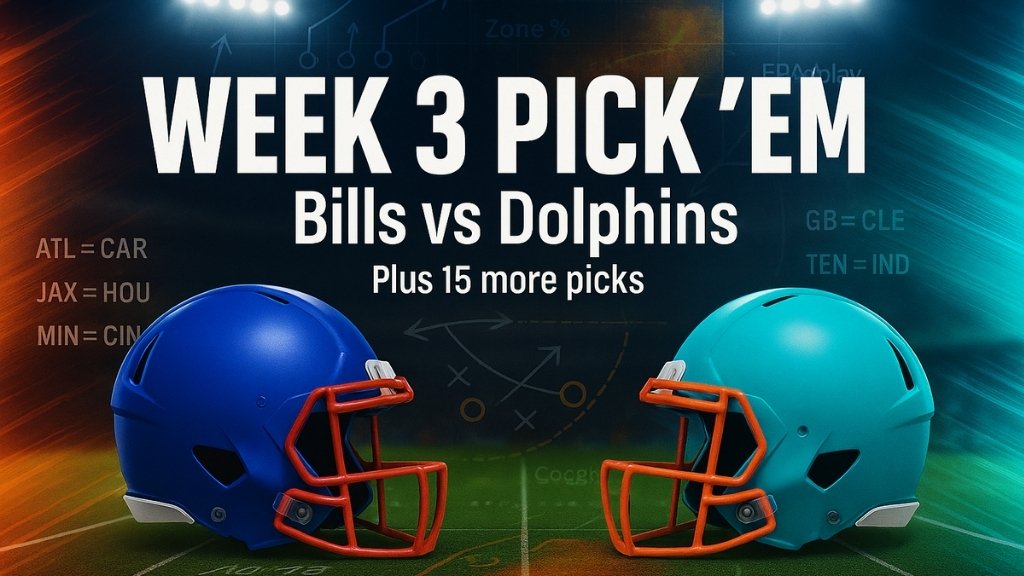Buffalo enters NFL Week 3 Picks with the look of a team that’s comfortable living in zone on defense and explosive against zone on offense, a combination that tends to squeeze Miami’s timing routes and punish soft spots over the middle. If the Bills keep Josh Allen on script—quick decisions, calculated shots, and timely scrambles—the Dolphins will be forced to string together long, mistake-free drives against a unit that rallies and tackles.
The hinge is early down success: if Buffalo consistently faces second-and-short, play-action becomes a cudgel and Miami’s pass rush gets neutralized, setting up a methodical, scoreboard-controlling win.
Panthers vs. Falcons
Atlanta’s identity is clear: a zone-heavy defense that dares young quarterbacks to throw into tight windows and a ball-control offense that leans on rhythm and field position. That formula is kryptonite for a developing passer who needs clean first reads and consistent pockets. Expect the Falcons to keep everything in front, tackle well after the catch, and tilt the field with patient drives. If Carolina can’t manufacture explosive plays or a short field via takeaways, Atlanta’s measured approach should create a comfortable margin late.
Jaguars vs. Texans
This one swings on Jacksonville’s ability to stress Houston horizontally before striking vertically. When the Jaguars stay balanced—screens, quick outs, and outside zone to stretch the front—they open space for intermediate crossers that can flip drives. Houston’s counter is a disciplined zone structure and red-zone toughness; if the Texans compress space inside the 20 and turn touchdowns into field goals, they can keep this inside one score deep into the fourth, especially if their run game finds a workable rhythm on early downs.
Vikings vs. Bengals
Minnesota’s route concepts thrive when the quarterback is on time and the protection identifies pressure looks pre-snap; if that clicks, the Vikings can attack the Bengals’ underneath voids with layered digs and outs. Cincinnati’s path is to muddy the picture—late safety rotation, simulated pressure, and rerouting at the line—to force hesitation and set up third-and-long. The first quarter will tell the story: clean pockets and rhythm favor Minnesota, while disguised pressures and field-position wins keep the Bengals in striking distance.
Browns vs. Packers
Green Bay’s defense is built to cap explosives and rally to the ball, an unsexy but effective plan against a Cleveland offense that needs balance to be efficient. If the Packers’ front holds up versus the run on early downs, they can sit in zone shells, discourage deep shots, and squeeze throwing windows between the numbers. On the other side, Green Bay’s offense doesn’t need fireworks—steady chains, play-action slants, and red-zone efficiency should be enough in a game where 24 points may feel like 30.
Titans vs. Colts
Tennessee’s rookie QB has taken lumps against elite fronts, but this matchup offers a fair measuring stick: diagnose, deliver, and avoid the killer turnover. Indianapolis, meanwhile, is most dangerous when the ball is out on time and the screen game punishes overaggression. If the Colts can keep their quarterback clean on third down, they’ll sustain the drives that wear down a proud Titans front. Special teams and hidden yards—returns, penalties, and touchback management—could be decisive in a grinder.
Commanders vs. Raiders
Washington’s offense looks most comfortable attacking zone with high-percentage throws that let playmakers finish; against Las Vegas, that means patient, chain-moving football rather than forcing hero balls outside the numbers. The Raiders need early splash plays—strip sacks, tipped-ball picks, or shot-play connections—to tilt the math. If Washington avoids self-inflicted wounds and stays ahead of schedule, its defense can tee off late with four-man rush and bracket coverage on third down.
Eagles vs. Rams
Philadelphia’s ceiling is tied to trench dominance; when the run game is efficient, the RPO and deep crossers follow naturally. The Rams complicate that with a disruptive front and a plan to widen the edges, encourage give reads, and rally from depth. This tilts toward a field-goal game where red-zone sequencing—QB draws, tight end leaks, and misdirection—decides it. Expect long drives, a premium on third-and-short, and a fourth-quarter possession that feels like the season hinges on it.
Buccaneers vs. Jets
Tampa Bay’s defensive mindset is simple: choke the run, earn obvious passing downs, and unleash pressure packages that bait conservative quarterbacks into checkdowns short of the sticks. The Jets must counter with quick rhythm throws and moving pockets to steal first downs. If the Buccaneers control the line of scrimmage and win early downs, their offense only needs to be steady—play-action slants, shallow crosses, and a patient ground game—to separate by the middle of the third.
Patriots vs. Steelers
New England’s path is creativity: misdirection runs, orbit motion, and layered play-action to manufacture clean looks for a young passer who thrives on defined reads. Pittsburgh fights back with physicality at the catch point and a pass rush that feasts on long down-and-distance. Whichever team dictates the intermediate middle—those 8-to-14-yard windows on second-and-medium—will own time of possession. One turnover in plus territory may be the only real difference.
Seahawks vs. Saints
Seattle’s heavy-zone identity forces opponents to stack patient completions, a challenge for any offense that prefers shot plays or needs yards after catch to live. If the Seahawks tackle cleanly and win the field-position battle with their punt unit, they can compress the game and lean on a balanced attack—outside zone, boot action, and selective deep shots—to create a two-score cushion. New Orleans’ best chance is scripted aggression early; if that fizzles, Seattle’s tempo control takes over.
Chargers vs. Broncos
When Justin Herbert is in rhythm, the Chargers can defeat almost any coverage family by attacking leverage: option routes versus man, curls-to-go’s versus zone, and backs releasing into voids when blitzers vacate. Denver must toggle between simulated pressure and drop-eight looks to steal a possession or two. If L.A. protects decently and avoids red-zone stalls, their efficiency on third down will tilt the snap count and the scoreboard.
49ers vs. Cardinals
San Francisco’s offense is a masterclass in sequencing—wide zone to split zone to play-action crossers—designed to punish linebackers’ eyes. Arizona has to win with disruptive negatives: early run stuffs, a sack to derail a drive, or a timely takeaway. If the Cardinals can’t create chaos, the 49ers will keep stacking efficient plays and wear down the secondary with motion and yards-after-catch, turning a close game into a controlled finish.
Bears vs. Cowboys
Dallas doesn’t need a track meet to win; it needs precision on third down and red-zone ruthlessness. Against a Chicago secondary that can thin out late, Dak Prescott’s accuracy on outbreaking routes and seam throws is the quiet separator. The Bears must lean on clock-draining drives and finish with sevens, not threes. If they blink in the red area, Dallas’ steady scoring tempo will make the final margin feel bigger than the yardage totals suggest.
Giants vs. Chiefs
This is less about Kansas City’s fireworks and more about New York’s ability to contest the short game and tackle in space. If the Chiefs’ ground game can’t consistently punish light boxes, the Giants can play two high, squeeze intermediate windows, and keep it a one-score affair into the fourth. Kansas City still carries the playmaking trump card, but New York’s path to a cover is real: win special teams, limit explosives, and steal one possession with a well-timed pressure look.
Ravens vs. Lions
Baltimore brings physicality and structure; Detroit brings explosive offense and a pass rush that flips drives with timely sacks. Expect constant momentum swings and high-leverage fourth-quarter decisions—fourth-and-short near midfield, two-point calculus, and clock management. If the Lions protect well enough to hit their intermediate shots while the Ravens control the run game on early downs, this turns into a last-possession coin flip where either side can justify the number.
Note: The analysis above is written in original language, organized into long paragraphs under H2 headings, and avoids external links as requested. It’s designed to serve as a clean, publish-ready “NFL Week 3 Picks” breakdown that emphasizes matchup tendencies, game flow, and situational football rather than raw odds.







